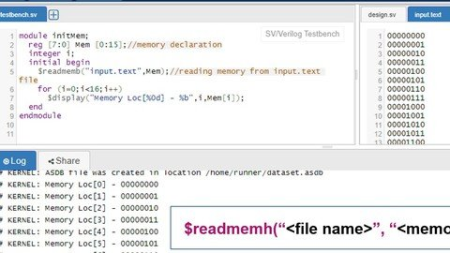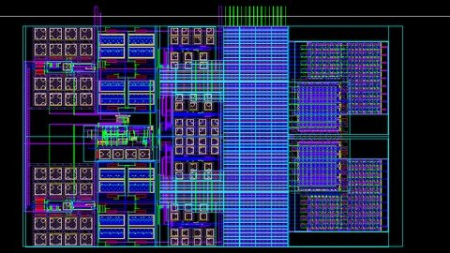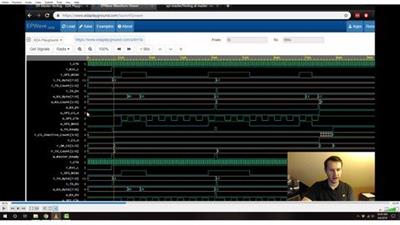
Complete Verilog Hdl Programming With Examples And Projects
Posted on 17 Jun 04:21 | by LeeAndro | 19 views

Last updated 6/2022MP4 | Video: h264, 1280x720 | Audio: AAC, 44.1 KHzLanguage: English | Size: 3.45 GB | Duration: 8h 3m
Fundamentals, Design flow, modeling levels, Datatypes, test bench, Tasks & system tasks, FSM, FPGA & examples & Projects
What you'll learn
Learning Verilog HDL Programming fundamental concepts and properties compare to C Language, feature & advantages of Verilog HDL over VHDL
VLSI Design flow ( FPGA & ASIC) and Difference between FPGA vs ASIC
Different design methodologies in Verilog HDL programming with examples
Behavioral modeling with blocking & Non-Blocking concepts and real examples
Test bench Verilog program with examples
Task & system tasks with examples for random data generator, file based operations and memory load operations, and file representation input & output etc.
Finite state machine (FSM) with example for both Mealy & Moore and Sequence detector FSM
Complete design & test bench programming for Memory controllers
Complete design & test bench programming for FIFO controller
Complete design & test bench programming for Encoder & decoder for Hamming code Error detection correction
Basics of FPGA
Requirements
Intension to learn
basic in C Language
basics in Digital design ( not compulsory)
Description
Complete Verilog HDL programming course with a perfect, well structured and concise course for freshers and experienced, as it is from fundamental level to the application level. This course discuss the concepts in Verilog HDL programming and properties compared with C-Language and discussing the features and advantages. In this course we give information related to VLSI design flow for FPGA & ASIC and gives overview about both.This course gives information on different styles of programming like Gate level, Data flow, Behavioral and switch level with examples. This course gives clear picture on verification, i.e. simulation and writing a test bench and some general examples like counter, clock diver using counter, pulse generator. This courses explains how to write verification models using test benches with task and system tasks with Examples. These examples includes, file based system tasks such as writing data in to file, reading data from file and loading data in to memory and random data generator. This courses shows clear picture on Finite State Machines (FSM) how to draw, how to realize it in to hardware model how ro translate in to verilog code for both Mealy & Moore FSM with examples. This course also shows some projects like Memory controller, FIFO controller and Error detection & correction using Hamming code, this improves ability to analyse and approach to Projects. Finally it gives basic knowledge on FPGA's like core concept how bit file is loaded in to FPGA.
Overview
Section 1: Introduction to the course
Lecture 1 Preview - course content
Lecture 2 Sample program on edaplayground
Section 2: Introduction to Verilog HDL
Lecture 3 Verilog fundamentals
Section 3: VLSI design flow ( FPGA & ASIC)
Lecture 4 VLSI Design flow (FPGA & ASIC)
Lecture 5 FPGA vs ASIC
Section 4: Three levels of verilog design Description
Lecture 6 Three levels of verilog design Description
Lecture 7 Example: mux_2x1 with 3 abstracts models
Section 5: Verilog Language constructs, Data types & Compiler Directives
Lecture 8 Language constructs -Comments, keywords, identifier, Number specific, Operators
Lecture 9 Datatypes - net,reg, integer, real, string, , Parameter, Vector,Array,Memory
Lecture 10 Compiler Directives
Section 6: Verilog Program structure
Lecture 11 Verilog Program Structure -Module
Lecture 12 Ports
Lecture 13 Port Connection Rules
Lecture 14 Design Methodologies Approaches
Section 7: Gate level modeling
Lecture 15 Gate Level Model Introduction
Lecture 16 Example: 4x1 Mux
Lecture 17 Example: Full Adder
Lecture 18 Tri-state Buffers with Examples
Lecture 19 Array of Instance with example
Section 8: Data flow modeling
Lecture 20 Data flow Modeling : assign statement
Lecture 21 Operators
Lecture 22 Arithmetic Operators
Lecture 23 Logical Operators
Lecture 24 Example : Full Adder: Logical operators
Lecture 25 Example : Full Adder: Arithmetic operators
Lecture 26 Example: Binary to Gray code converter
Lecture 27 Logical and , Logical or (&&, )
Lecture 28 Shift operators : Left/right Shift
Lecture 29 Shifting without shift operator , just with concatenation operator
Lecture 30 Ternary operator : Example : 2x1 MUX, 4x1 MUX
Lecture 31 Relational operators Example: Comparator
Lecture 32 Equality , case Equality operators
Lecture 33 Reduction operator : Example: Parity Generator
Section 9: Behavioral Modeling
Lecture 34 Behavioral Modeling - Introduction
Lecture 35 Behavioral Modeling Constructs
Lecture 36 Procedural Blocks- initial & always
Lecture 37 Example: Clock Generation
Lecture 38 Assignment Statements - Blocking & Non-blocking
Lecture 39 Mechanism in Non-blocking
Lecture 40 Concurrency
Lecture 41 Advantage of Non-blocking assignment: Example: swapping
Lecture 42 Advantage of Non-blocking assignment: Example : Pipelining
Lecture 43 if-else: statement: Example : 4x1 Mux
Lecture 44 Case – statement : Example : 4x1 Mux
Lecture 45 Advantage of Case over if-else
Lecture 46 Loops: while, for, repeat, forever
Lecture 47 Parallel blocks - fork-join
Lecture 48 Combinational Logic circuits: List of Examples
Lecture 49 Example: 8x1 mux with 4x1 and 2x1
Lecture 50 Example: AND gate using 2x1 Mux
Lecture 51 Example: 1x8 Demux
Lecture 52 Example: Full Adder & 4-bit Full Adder
Lecture 53 Example : 3x8 Decoder and 3x8 Decoder using 2x4 decoder
Lecture 54 Example : 8x3 encoder
Lecture 55 Example : Priority encoder
Lecture 56 Example : Seven Snt Display
Lecture 57 Example : ALU
Lecture 58 Sequential Logic Circuits: List of Examples
Lecture 59 Example: D Flip Flop vs D-Latch
Lecture 60 Example: Synchronous Reset D-Flip flop , Asynchronous Reset D-Flip flop
Lecture 61 Example : T-Flip Flop
Lecture 62 Example : Master-slave JK Flip Flop
Lecture 63 Example: Counter
Lecture 64 Example: UP/Down Counter
Lecture 65 Example: clock divider using counter- Divide by 2,4,8,....
Lecture 66 Example: Pulse Generator: Mod-3 pulse generator
Lecture 67 Example: Divide by 3 clock
Lecture 68 Example : Ring Counter vs Jonson Counter
Lecture 69 Example : Shift Registers : SISO, SIPO, PISO,PIPO
Lecture 70 Example: LFSR (Linear Feedback Shift Register)- Random Generator
Lecture 71 memory design
Section 10: Switch level modeling
Lecture 72 Switch level modeling
Section 11: Test bench
Lecture 73 Functional simulation
Lecture 74 Example - Test bench for counter design
Lecture 75 Example - Test bench for Pulse generator
Section 12: Functions & Task and system tasks
Lecture 76 Functions & tasks and system tasks
Lecture 77 File based system tasks and random generator system task
Lecture 78 Read file and write in to memory system task
Lecture 79 Programming Language Interface
Section 13: FSM
Lecture 80 FSM Topics
Lecture 81 Why FSM
Lecture 82 What is FSM
Lecture 83 Hardware Realization of FSM : Component or Modules in FSM
Lecture 84 Types of FSM and Mealy Moore FSM differences
Lecture 85 Example : Mealy FSM
Lecture 86 Example: Moore FSM
Lecture 87 Example: Verilog HDL for Mealy FSM
Lecture 88 Example: Verilog HDL for Moore FSM
Lecture 89 Hands-on : Verilog HDL for Mealy FSM and run the execution
Lecture 90 Example: Divide by 2 clk using FSM
Lecture 91 Example: Divide by 3 clk using FSM
Lecture 92 Example: 33 perecent duty cycle clock generation using FSM
Section 14: Sequence detector using FSM with complete Design & TB
Lecture 93 Sequence detector using FSM with complete Design & TB
Lecture 94 Sequence detector using FSM output waveform
Section 15: Project 1: Memory controller
Lecture 95 Memory controller with Design & TB
Section 16: Project 2: FIFO
Lecture 96 FIFO Lecture
Lecture 97 Introduction to FIFO
Lecture 98 Write Read Operation of Normal RAM
Lecture 99 FIFO I/O (input & Outputs)
Lecture 100 Block Diagram and Architecture of FIFO
Lecture 101 Connection of FIFO design & Test bench environment
Lecture 102 Verilog HDL for FIFO design
Lecture 103 Verilog HDL code for FIFO Test Bench
Lecture 104 Run the simulation and finding errors and Analyze the waveform Results
Section 17: Project 3 : Hamming code complete Design & TB for error detection & correction
Lecture 105 Hamming code complete Design & TB for error detection & correction
Section 18: FPGA
Lecture 106 FPGA
Undergraduate Electronics and computer science eeering students,Graduate students who planning their career in VLSI domain front end (Design & verification),Advanced under graduate students, who willing to do project in front end VLSI design
HomePage:
Https://anonymz.com/https://www.udemy.com/course/digital-design-using-verilog-hdl-programming-with-practical/DOWNLOAD
uploadgig.com
https://uploadgig.com/file/download/BA7b8631eA5c5337/f2yTs23H__Complete_V.part1.rar
https://uploadgig.com/file/download/Eb1252641730b6a3/f2yTs23H__Complete_V.part2.rar
https://uploadgig.com/file/download/5c6c1f35ec6744ae/f2yTs23H__Complete_V.part3.rar
https://uploadgig.com/file/download/67ea3c50C8b885DF/f2yTs23H__Complete_V.part4.rar
rapidgator.net
https://rapidgator.net/file/19caabbd0a6f31bae3e4394d0fd5c94d/f2yTs23H__Complete_V.part1.rar.html
https://rapidgator.net/file/353353c177a13e3a67bab8fc32328851/f2yTs23H__Complete_V.part2.rar.html
https://rapidgator.net/file/27c269b1acc0dbfc47d2f1d77a03c707/f2yTs23H__Complete_V.part3.rar.html
https://rapidgator.net/file/af4216b3544799cf12877d7ab6775963/f2yTs23H__Complete_V.part4.rar.html
nitro.download
https://nitro.download/view/114B5C05E7D3382/f2yTs23H__Complete_V.part1.rar
https://nitro.download/view/1248EAF5B92116E/f2yTs23H__Complete_V.part2.rar
https://nitro.download/view/0BBF7439C339FDD/f2yTs23H__Complete_V.part3.rar
https://nitro.download/view/6BFDA6FCC45C1EB/f2yTs23H__Complete_V.part4.rar
Related News
System Comment
Information
 Users of Visitor are not allowed to comment this publication.
Users of Visitor are not allowed to comment this publication.
Facebook Comment
Member Area
Top News



